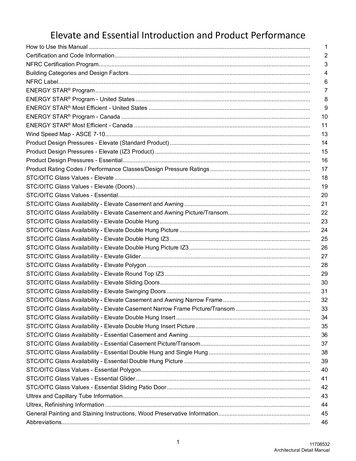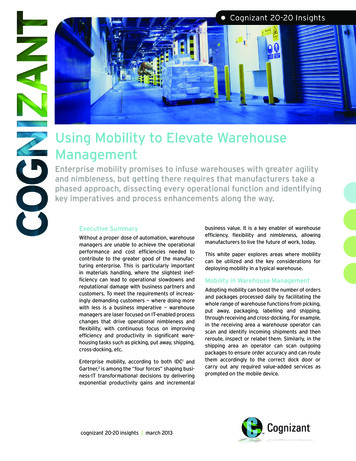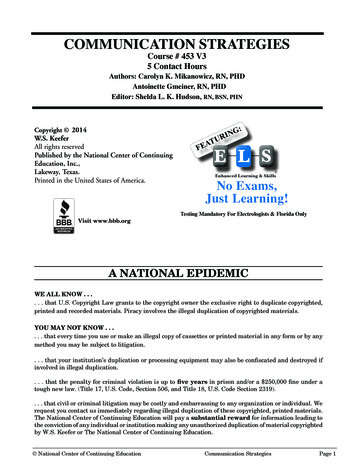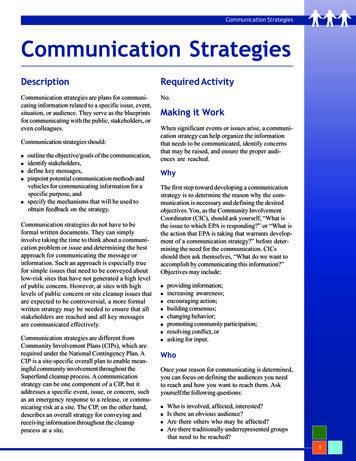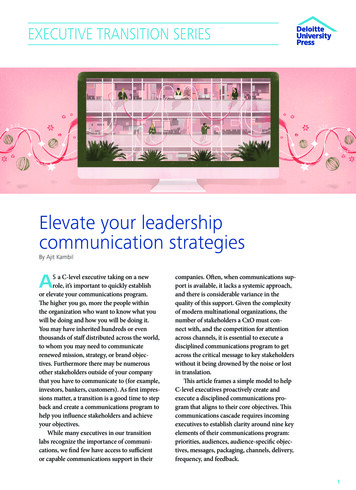
Transcription
EXECUTIVE TRANSITION SERIESElevate your leadershipcommunication strategiesBy Ajit KambilAS a C-level executive taking on a newrole, it’s important to quickly establishor elevate your communications program.The higher you go, more the people withinthe organization who want to know what youwill be doing and how you will be doing it.You may have inherited hundreds or eventhousands of staff distributed across the world,to whom you may need to communicaterenewed mission, strategy, or brand objectives. Furthermore there may be numerousother stakeholders outside of your companythat you have to communicate to (for example,investors, bankers, customers). As first impressions matter, a transition is a good time to stepback and create a communications program tohelp you influence stakeholders and achieveyour objectives.While many executives in our transitionlabs recognize the importance of communications, we find few have access to sufficientor capable communications support in theircompanies. Often, when communications support is available, it lacks a systemic approach,and there is considerable variance in thequality of this support. Given the complexityof modern multinational organizations, thenumber of stakeholders a CxO must connect with, and the competition for attentionacross channels, it is essential to execute adisciplined communications program to getacross the critical message to key stakeholderswithout it being drowned by the noise or lostin translation.This article frames a simple model to helpC-level executives proactively create andexecute a disciplined communications program that aligns to their core objectives. Thiscommunications cascade requires incomingexecutives to establish clarity around nine keyelements of their communications program:priorities, audiences, audience-specific objectives, messages, packaging, channels, delivery,frequency, and feedback.1
EXECUTIVE TRANSITIONS SERIESElevate your leadership communication strategiesCONVERSATION VERSUS COMMUNICATIONThe communications cascade may seem like a hierarchical structured template for one-way communications fromyou to an audience. It does not have to be so. You may have positions and viewpoints you communicate throughconversations and dialogue with other stakeholders. Indeed you may modify your positions and viewpoints basedon the dialogues with stakeholders. Conversations are part of the communications process, useful for establishingmutual understanding and revising priorities and messages. The cascade, while appearing linear, is not meant tobe a one-time effort. Instead it should be a dynamic process with feedback that is reviewed and reshaped every sixmonths or so to be relevant, timely, and effective.1. Align communications to your priorities. A goodstarting point would be your core go-forward priorities. In a previous article we looked at how to elevatorpitch your top priorities.1 Once you have clarity onkey priorities, it makes sense to create a communications strategy specific to each priority, which thenbecomes part of an overall communications program.2. Define critical audiences. For each priority, defineyour critical audiences. Who do you need to communicate to? Who do you need to hear from? Asan incoming CFO, for example, you can have manydifferent audiences you need to communicate to.These may be your direct-report leadership team,your entire finance organization, the executive committee, the whole company. The first step to a communications strategy for a specific priority is to definethe audiences.3. Define audience-specific objectives around eachpriority. Let us assume that as a CFO, your priorityis to create a more accountable finance organizationthat delivers insights and value to the businesses.With each audience, you are likely to have differentgoals. For example, initially, with your direct leadership team, your goal may be to have them step up andtake more responsibility for decisions and deliveryof insights to stakeholders. With the CEO and peerexecutives, your goal may be to demonstrate progresson your objective. Thus, for each priority you mayhave different communication intents and goals fordifferent audiences.4. Define critical messages. For each audience under apriority, there will be different messages at differentpoints of time. From the above example of creating amore accountable finance organization that deliversinsights and value to the business units, you are likelyto have different messages for your staff and yourbusiness peers at different times. With your team,you may first want to communicate revised expectations. Next, you may want to communicate examplesof behaviors and actions that create the value youwant to demonstrate to the businesses. Finally, youmay want to establish a scorecard that helps yourteam track progress against the objective. With yourpeers and the CEO, you may want to communicatetimelines for forthcoming actions, such as upgrading select staff, and also report tangible ways financeadded insights to the business to demonstrate progress on this objective. In short, having your strawman messages to different audiences clarified across atimeline can help with the effective construction anddistribution of messages as needed.5. Package your messages. Once you have defined somekey messages, the next step is to consider how theyare best packaged for delivery. The key here is that2
EXECUTIVE TRANSITIONS SERIESElevate your leadership communication strategiesBEWARE OF THE INAUTHENTIC AND INANEToday there is a proliferation of electronic communications channels within and across organizations—Yammer,LinkedIn, Twitter, Facebook, and so on. As a leader, you may be counseled to be present on these channels by yourmarketing and communications staff; they may even write messages for you to disperse on these channels. Someeven directly send messages on your behalf. Do not feel compelled to post communications on these channels justbecause they are available—doing so without care makes you look inauthentic and inane. For example, I oftenget recommendations on so-called thought leadership pop up on my LinkedIn feed from executives—with a oneliner such as “Great article on the future of X.” When you open the article and find it to be lame, it simply makesyou think the executive who endorsed it is inauthentic or inane. They probably never read it (thus inauthentic) andprobably left it to someone else to formulate their post. These new online channels are useful tools when you areauthentic and credible in using them to effectively connect with key stakeholders. But beware of serial endorsingand other such online communication behaviors. Your name may appear frequently online but also adverselyundermine your credibility. If you endorse a piece, say why it personally resonated with you and at least read itbefore endorsing it. Be discerning in your online communications and choose to be credible and authentic by trulypersonalizing them.your intended audience understands and, ideally,responds to your message in a way that you want.So, will your messages be communicated as storiesor will they be communicated in a factual report ordata dashboard? Will the messages be communicatedthrough direct requests and conversations? Differenttypes of messages are best packaged in a format thatbest conveys the message. Generally where behavioral or belief changes are required, stories may be amore memorable and effective format (see Gallo andDenning on the power of stories).2Given the adage a picture is worth a thousand words,packaging also means considering how messages willbe conveyed—through infographics, videos, and otherformats that are impactful to audiences.Another aspect of packaging is to carefully considerthe language and cultural fit of the examples and stories you will use. In modern global companies, wheresignificant operations are located in countries thatspeak a different language, you may also want to havea local manager either translate or communicate onyour behalf, and ensure your messages and stories areculturally appropriate.6. Think through who will deliver the messages. Whenyou define a communications program, you do nothave to deliver it all by yourself. Sometimes it is moreeffective when others deliver messages on your behalf.Whether it is your leadership team or staff sharingtheir experiences in a town hall, including others inthe communication of the message can help demonstrate critical team behaviors. When others deliverthe messages in addition to you, it can show visiblecommitment from team and peer leaders. Peer storiesmay also be more powerful in their impact than topdown messages.7. Select channels for communication. Today, executives have numerous channels for communicationwithin the organization and externally. Email, worknetworking systems like Yammer, LinkedIn, andTwitter combined with video, teleconferencing, andwebcasting provide a plethora of electronic optionswith a wide reach. These can also be combined within-person town halls and other meeting formats tocombine in-person conversations and broad onlinecommunications. Select your communication channels depending on the nature of the messages, theimportance of different stakeholders, the number of stakeholders to communicate to, and theirgeographic dispersion.8. Define communication frequency. For each priority,audience, message, and channel, define the frequencyof your communications. For example, as a CFO,you may work with the CEO and go over quarterlyearnings in a companywide town hall. For your entire3
EXECUTIVE TRANSITIONS SERIESElevate your leadership communication strategiesorganization you may similarly do a town hall onceor twice a year to ensure alignment of objectives andpriorities. For other communications you may needto set up in-person meetings. Defining the frequencyand channels can help clarify the demands of a communications program on your available time.9. Seek feedback and evaluate your communications.To assess if your communications strategy is working, you may want to get feedback from your differentaudiences. You can get feedback from direct conversations with a sampling of your audiences, where youget a chance to assess how well they understand yourmessages and agenda. For events such as web seminars and town halls, you can use online surveys togather feedback on the effectiveness of these communications. Feedback can help shape improvements tothe communications program.The communications cascade above provides asystematic approach toward building a communications program. You can use it to ask an insourced oroutsourced communications professional to shape acommunications strategy for each of your individualpriorities and audiences, and an overall program for youearly in your transition. Given that attention is a scarceresource, it is important for the communications professional to design an overall program that is respectful ofthe different audiences’ and your time.A good communications program also helps youassess how much effort and time you will have to putinto communications. It will clarify your messages andways of engaging critical stakeholders. An authentic andcredible communications program can help persuadeand inform key stakeholders on your intentions andsuccesses, and this in turn can accelerate your impact onthe organization.TakeawayAll too often, senior executives underestimate thecommunications effort required to influence and makea difference in their organization. Frequently, internalcommunications support for senior executives is eitherunavailable beyond the CEO’s office or, when available, isad hoc and not systematic. Working through the communications cascade early in the transition with a goodcommunications professional can help you clarify yourasks of them, and both frame and execute a systematiccommunications agenda efficiently to achieve yourorganizational objectives.Dr. Ajit Kambil is the global research director for the CFO program and the creator of Deloitte’s Executive Transition Labs.4
EXECUTIVE TRANSITIONS SERIESElevate your leadership communication strategiesFollow @DU PressSign up for Deloitte University Press updates at DUPress.com.About Deloitte University PressDeloitte University Press publishes original articles, reports and periodicals that provide insights for businesses, the public sector andNGOs. Our goal is to draw upon research and experience from throughout our professional services organization, and that of coauthors inacademia and business, to advance the conversation on a broad spectrum of topics of interest to executives and government leaders.Deloitte University Press is an imprint of Deloitte Development LLC.About this publicationThis publication contains general information only, and none of Deloitte Touche Tohmatsu Limited, its member firms, or their relatedentities (collectively the “Deloitte Network”) is, by means of this publication, rendering professional advice or services. Before making anydecision or taking any action that may affect your finances or your business, you should consult a qualified professional adviser. No entityin the Deloitte Network shall be responsible for any loss whatsoever sustained by any person who relies on this publication.About DeloitteDeloitte refers to one or more of Deloitte Touche Tohmatsu Limited, a UK private company limited by guarantee (“DTTL”), its network ofmember firms, and their related entities. DTTL and each of its member firms are legally separate and independent entities. DTTL (alsoreferred to as “Deloitte Global”) does not provide services to clients. Please see www.deloitte.com/about for a more detailed descriptionof DTTL and its member firms.Deloitte provides audit, tax, consulting, and financial advisory services to public and private clients spanning multiple industries. Witha globally connected network of member firms in more than 150 countries and territories, Deloitte brings world-class capabilities andhigh-qual
munications strategy for a specific priority is to define the audiences. 3. Define audience-specific objectives around each priority. Let us assume that as a CFO, your priority is to create a more accountable finance organization that delivers insights and value to the businesses. With each audience, you are likely to have different goals. For example, initially, with your direct leader-

